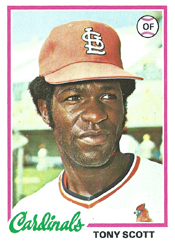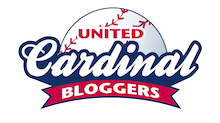Initially perceived as a marginal player in an unimportant trade, Tony Scott replaced Bake McBride in center field for the Cardinals and was their most prominent starter at that position until Willie McGee claimed the role.
 Though Scott got his chance with the Cardinals because of his connections to Vern Rapp, it was under another manager, Ken Boyer, with whom Scott had his best St. Louis season.
Though Scott got his chance with the Cardinals because of his connections to Vern Rapp, it was under another manager, Ken Boyer, with whom Scott had his best St. Louis season.
On Nov. 8, 1976, the Cardinals traded pitchers Bill Grief and Angel Torres and outfielder Sam Mejias to the Expos for pitcher Steve Dunning, infielder Pat Scanlon and Scott.
Underwhelmed by the transaction, Dick Kaegel of the St. Louis Post-Dispatch wrote, “On the surface, it looks like one of those meaningless exchanges of baseball bodies, a deal that could hurt both clubs.”
Rapp’s guys
Dunning, Scanlon and Scott all had played in 1976 for Rapp, who managed Denver, the Class AAA club of the Expos.
In comments to The Sporting News, Scott said of Rapp, “He handles players right. He always gives people a fair shot. He made a winner out of everybody. It was a great experience to play for him.”
After the 1976 season, Rapp was chosen by the Cardinals to replace Red Schoendienst as manager.
On Rapp’s recommendation, Cardinals general manager Bing Devine made the trade for Dunning, Scanlon and Scott.
Devine said the key player for St. Louis was Dunning, a right-handed reliever who had been a first-round choice of the Indians in the 1970 draft. Dunning, 27, split the 1976 season between the Expos (2-6, 414 ERA) and Denver (3-0, 2.74 ERA).
The Cardinals hoped Scanlon could provide pop as a pinch-hitter. Scanlon, 24, hit .308 with 18 home runs for Denver in 1976.
Odd fit
Scott, 25, seemed the least likely to fit in with the 1977 Cardinals, who were flush with outfielders such as McBride, Lou Brock, Hector Cruz, Jerry Mumphrey and Mike Anderson.
McBride, who won the National League Rookie of the Year Award in 1974, had been limited to 64 starts in center field for the 1976 Cardinals because of knee surgery, but he was expected to be recovered in 1977.
Scott, a switch-hitter, had batted .182 with the 1975 Expos after having spent parts of the 1973 and 1974 seasons with them. At Denver in 1976, Scott batted .311 with 21 doubles, 18 stolen bases and an on-base percentage of .361.
Regarding Scott’s play in center, Rapp said, “Denver has one of the larger fields in baseball. Tony had a lot of room to run and he did a good job.”
Unimpressed, Ian MacDonald of The Sporting News wrote, “The Expos were in the market for a good defensive outfielder and they feel that they may have their man in Mejias.”
Job won
Scott played in the Puerto Rican Winter League after his trade to the Cardinals and established a single-season record with 25 stolen bases, including three steals of home.
After a strong spring training, Scott opened the 1977 season as a Cardinals reserve outfielder. The starters were Brock in left, McBride in center and Cruz in right.
Neither Dunning nor Scanlon would play for the Cardinals.
Scott sizzled from the start. He batted .357 (10-for-28) in April and .355 (27-for-76) in May.
Meanwhile, McBride, hampered by a shoulder injury, was feuding with Rapp, who had banned his players from growing long hair or facial hair.
In The Sporting News, Neal Russo wrote, “Rapp was not on the greatest of terms with McBride. It was Bake who became the first to defy the new manager on his hair code.”
On June 15, 1977, the Cardinals traded McBride to the Phillies and made Scott the center field starter. McBride, who had hit .300 or better in each of his first four seasons (1973-76) with the Cardinals, was batting .262 when traded. Scott had a .331 batting average.
Redbird regular
Scott finished the 1977 season with a .291 batting mark, 16 doubles and 13 stolen bases in 95 games.
Scott opened the 1978 season as the Cardinals’ starting center fielder. In April, Rapp was fired and replaced by Boyer. A month later, the Cardinals acquired George Hendrick from the Padres and made him their everyday center fielder. Scott hit .228 in 96 games.
In 1979, Boyer moved Hendrick to right field and reinserted Scott at center field. Scott responded with a solid season: .259 batting average, 152 hits in 153 games, 22 doubles, 10 triples, 68 RBI (including eight sacrifice flies) and 37 stolen bases. Scott also ranked first among NL center fielders in assists (13) and third in putouts (398).
Scott again was the Cardinals’ starting center fielder in 1980 _ he ranked first among NL center fielders in fielding percentage at .997 _ and at the beginning of 1981.
On June 7, 1981, the Cardinals traded Scott to the Astros for pitcher Joaquin Andujar. The following year, McGee emerged as the Cardinals’ everyday center fielder. McGee and Andujar played prominent roles in helping the 1982 Cardinals to a World Series championship.
In five seasons (1977-81) with the Cardinals, Scott batted .255.

Tony Scott was no hall of fame, but still, he was a big part of the team his whole time here. And with this said, the Cardinals can consider themselves fortunate that Scott turned out to be a pleasant surprise. McBride should have never been traded.
Yes, Bake McBride went on to bat .292 in five seasons with Phillies, producing 616 hits in 553 regular-season games. He also played for them in four postseasons: 1977, 1978, 1980 and 1981.